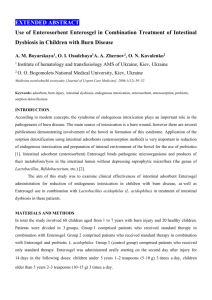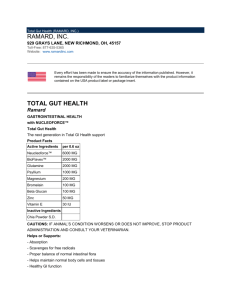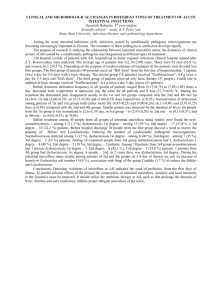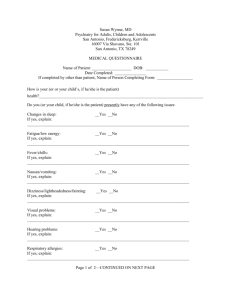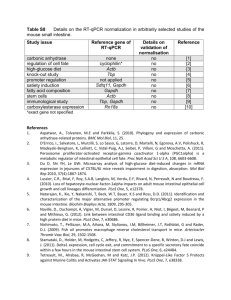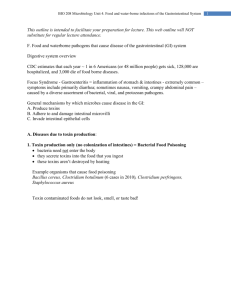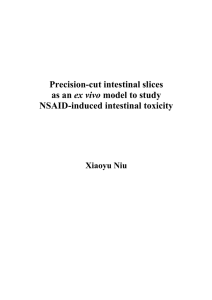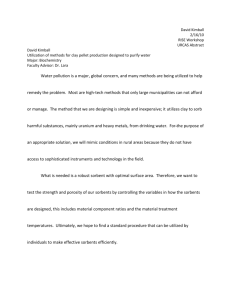The Detoxifying Potential and Clinical Effectiveness of
advertisement
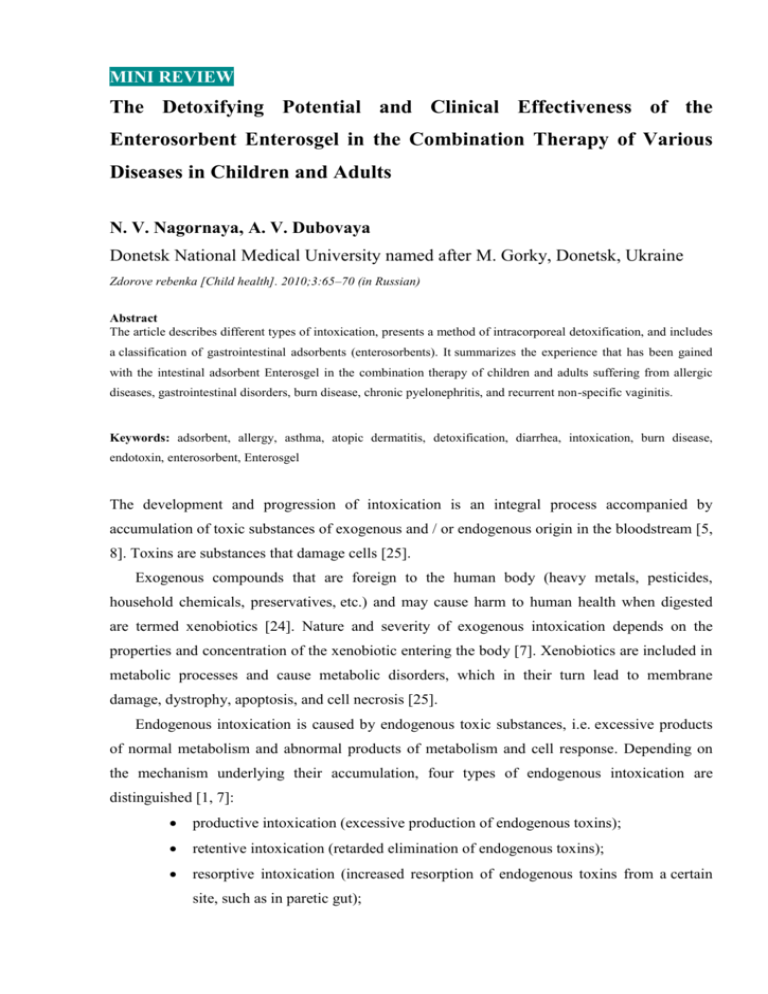
MINI REVIEW The Detoxifying Potential and Clinical Effectiveness of the Enterosorbent Enterosgel in the Combination Therapy of Various Diseases in Children and Adults N. V. Nagornaya, А. V. Dubovaya Donetsk National Medical University named after M. Gorky, Donetsk, Ukraine Zdorove rebenka [Child health]. 2010;3:65–70 (in Russian) Abstract The article describes different types of intoxication, presents a method of intracorporeal detoxification, and includes a classification of gastrointestinal adsorbents (enterosorbents). It summarizes the experience that has been gained with the intestinal adsorbent Enterosgel in the combination therapy of children and adults suffering from allergic diseases, gastrointestinal disorders, burn disease, chronic pyelonephritis, and recurrent non-specific vaginitis. Keywords: adsorbent, allergy, asthma, atopic dermatitis, detoxification, diarrhea, intoxication, burn disease, endotoxin, enterosorbent, Enterosgel The development and progression of intoxication is an integral process accompanied by accumulation of toxic substances of exogenous and / or endogenous origin in the bloodstream [5, 8]. Toxins are substances that damage cells [25]. Exogenous compounds that are foreign to the human body (heavy metals, pesticides, household chemicals, preservatives, etc.) and may cause harm to human health when digested are termed xenobiotics [24]. Nature and severity of exogenous intoxication depends on the properties and concentration of the xenobiotic entering the body [7]. Xenobiotics are included in metabolic processes and cause metabolic disorders, which in their turn lead to membrane damage, dystrophy, apoptosis, and cell necrosis [25]. Endogenous intoxication is caused by endogenous toxic substances, i.e. excessive products of normal metabolism and abnormal products of metabolism and cell response. Depending on the mechanism underlying their accumulation, four types of endogenous intoxication are distinguished [1, 7]: productive intoxication (excessive production of endogenous toxins); retentive intoxication (retarded elimination of endogenous toxins); resorptive intoxication (increased resorption of endogenous toxins from a certain site, such as in paretic gut); infectious intoxication. According to G. P. Kozinets et al., toxins accumulating in the blood may have differently sized molecules, depending on the etiological and pathogenetic mechanisms of the disease [8]. As a result of metabolic disorders, toxins with molecules < 10 nm accumulate. Bacterial and exogenous toxins have molecules measuring 10–200 nm. Toxins with molecules > 200 nm in diameter accumulate as a result of resorptive disturbances. Apart from the direct damage inflicted on the cells, toxins can have mediated effects resulting from their ability to trigger autoimmune reactions [25]. The functional system of detoxification (FSD) is composed of the lungs, liver, intestines, kidneys, and other organs responsible for dilution and mobilization of toxins, as well as their biotransformation and elimination [7]. An acute impact of endogenous toxins always results in a specific response at the organ and system levels, acute endotoxicosis [8]. The development of endotoxicosis is associated with FSD failure, generalized impairment of blood rheology, and altered immune responsiveness, which necessitates maintenance and replacement of suffering FSD elements by means of active detoxification [25]. There are two groups of active detoxification methods [25]: 1. Intracorporeal methods that augment the elimination effects of the FSD (forced diuresis, gastrointestinal adsorption, device-assisted or monitoring large intestinal purification, peritoneal dialysis, intestinal lavage, etc.). 2. Extracorporeal methods are capable of ensuring dilution and immobilization of toxic substances, their biotransformation, and intensified excretion through mass exchange devices (adsorption of blood, plasma, lymph, and cerebrospinal fluid, blood oxygenation, blood ozonation, plasmapheresis, haemodialysis, blood filtration, etc.). Gastrointestinal sorption (enterosorption) means therapeutic or prophylactic use of sorbents capable of binding metabolites, toxins, and other deleterious substances in the gastrointestinal tract and eliminating them from the body [24]. Sorbents may bind toxic substances by way of adsorption, absorption, ion exchange, and complex formation. V. G. Nikolaev distinguished the following principal mechanisms of action of gastrointestinal sorbents [14, 15]: adsorption of toxic substances entering the gastrointestinal tract from outside the body; adsorption of toxins entering the intestinal lumen from the blood by diffusion; binding of toxic substances secreted with the digestive juices; adsorption of toxic substances produced in the gastrointestinal tract (indole, skatole, etc.); sorptive modification of diet through selective adsorption of amino acids and free bile acids; fixation and transfer of physiologically active substances (enzymes, bile acids, etc.); change in the volume of undigested dietary fibers; catalytic action. Additional mechanisms of action of gastrointestinal sorbents are [14]: obducing and cytoprotective effects; improvement in the structure of intestinal contents; formation of aggregates and flocculates containing microorganisms and viruses; direct bactericidal activity; complex formation and chelation; modification of the chemical composition of intestinal contents (creating an environment unfavourable for proliferation of pathogenic flora). No conventional classification of oral sorbents is currently available. V. G. Nikolaev divided oral sorbents into a number of groups by chemical structure [14, 15]: carbon sorbents of generations I–IV; sorbents based on natural and synthetic resins, synthetic polymers, and indigestible lipids; silicon-containing sorbents, including organosilicon sorbents, aerosils, and clays; natural organic sorbents based on dietary fibers, hydrolysis lignin, chitin, pectin, and alginates; combined sorbents, which may include two or more types of the above enterosorbents. A widely preferred gastrointestinal sorbent option is Enterosgel [polymethylsiloxane polyhydrate (methylsilicic acid hydrogel)], which has a number of advantages over other sorbents. Numerous studies have demonstrated its high efficacy and effectiveness, selectivity of adsorption (as it binds and eliminates only toxic metabolites and pathogenic microflora), and safety [3, 4, 6, 10–12, 14–19, 22, 23]. Enterosgel is an organosilicon adsorbent designed to eliminate toxic substances from the body, correct intestinal microbiota, and restore epithelium in the gastrointestinal mucous membrane [1]. The drug demonstrates a high biocompatibility profile. The sorptive and detoxifying properties of Enterosgel are a result of its porous globular structure that predominantly includes medium-sized pores (mesopores), which allows to bind and eliminate toxins with a molecular weight of 70–1000 Da, toxic products of proteins, bilirubin, cholesterol, urea, and creatinine [21]. It has been proven that Enterosgel does not bind or eliminate micronutrients and other essential substances [3, 12, 13, 16, 22, 23]. The bactericidal properties of the adsorbent Enterosgel are due to its ability to bind and eliminate pathogenic microorganisms and their products or debris from the gastrointestinal tract and other ecological econiches (when the product is administrated). Adhesion involves Grampositive and Gram-negative microorganisms, Candida fungi, and viruses (rotaviruses and some others) [6, 12]. Enterosgel does not inhibit intestinal saprophytic microflora (lactobacilli, bifidobacteria, etc.) [4, 11, 17, 19]. As a result of adsorption of substances that irritate the mucous membrane (exogenous and endogenous pathogenic microflora, toxic metabolites), as well as the obducing and regenerative effects, Enterosgel helps recover mucous membranes [11, 19]. Enterosgel augments the immune protection provided by the epithelial barrier of the intestinal mucous membrane, which is manifested by elevated concentrations of IgА responsible for local immunity and preventing mucous lining from being invaded by microorganisms [4, 12, 17]. Enterosgel suppresses endotoxin aggression through binding endotoxins of Gram-negative bacteria [13, 16]. Endotoxin excesses present in the human body are known to complicate the course of many pathological processes [3]. A number of studies that have been conducted in recent years in Ukraine and other CIS member countries have demonstrated that Enterosgel can be successfully used in the combination treatment of various diseases, both in adults and in children. A study by О. I. Lasycja et al. assessed the effectiveness of Enterosgel therapy in the treatment of allergic diseases given together with conventional therapy. The study included 99 children aged from 4 months to 14 years who suffered from bronchial asthma, atopic dermatitis, recurrent urticaria, and angioneurotic oedema [9]. The administration of Enterosgel resulted in faster reduction of dermal-respiratory syndrome: rash elements were improved by the 3rd or 4th day of therapy and angioneurotic oedema was relieved by the 2nd or 3rd day in 75% of the patients. At the same time, the improvements observed in dermal-respiratory syndrome in control group patients were less significant and were only observed in 22% of these patients. А. А. Baranov et al. evaluated the efficacy of Enterosgel in the treatment of bronchial asthma and atopic dermatitis in children aged from 2.5 to 13 years [2]. All study subjects were administered broncholytic therapy. The children with severe bronchial asthma received inhaled corticosteroids, while the others were given cromoglicic acid. The experimental group subjects were given Enterosgel for 14 days as part of their combination treatment programme. An improvement occurred as soon as on the 3rd day of Enterosgel therapy: there were no more episodes of choking sensations, manifestations of the skin syndrome had been reduced, and gastrointestinal function had improved. The obstructive syndrome was eliminated by the 5th day of treatment in 50% of the patients, whereas respiratory function recovered by the 14th day of treatment. The children with atopic dermatitis presented with considerable improvements in the skin syndrome by the 5th day of treatment, while a complete remission was observed on treatment day 10 in 85% of subjects. Adolescent patients presented with significantly improved acne vulgaris rash. A clinical improvement was generally achieved in the Enterosgel group 7 to 10 days earlier than in the control group. No adverse drug reactions were observed in the patients on Enterosgel therapy. A publication by O. Yu. Poberezhnik et al. presented data on the use of Enterosgel in the treatment of allergic skin diseases [20]. The authors recruited 140 patients with acute eczema and acute allergic dermatitis. Rash was generalized in 60% of the patients and localized in 40% of them. All patients were divided into two groups: an experimental group (standard therapy + Enterosgel) and a control one (standard therapy). The patients in the experimental group had faster elimination of fresh skin rash elements, immune status normalization, and blood chemistry improvement, as compared with controls. I. V. Maev et al. investigated the effectiveness of Enterosgel in the treatment of gastrointestinal diseases accompanied by a chronic diarrhea syndrome in the adult patients [11]. They established a high clinical effectiveness of the intestinal adsorbent Enterosgel in this patient population, its favourable effects on the intestinal mucous membrane, digestion and absorption, as well as intestinal microbiota. An immunomodulating effect was detected. No adverse drug reactions were observed. V. N. Chernobrovyy and I. G. Paliy evaluated the potential of Enterosgel therapy in the treatment of large intestinal dysbiosis in the adult patients [4]. Fecal microbiology revealed intestinal dysbiosis in all study subjects: increased counts of E. coli haemolyticus and cocci, as well as positive tests for Klebsiella pneumoniae, S. аureus, and P. vulgaris. Clinical manifestations of large intestinal dysbiosis included abdominal flatulence, constipation, diarrhea, alternation of constipation and diarrhea, and periodic abdominal pain. The experimental group patients received conventional basic therapy (diet therapy, vitamin therapy, probiotics) and the intestinal adsorbent Enterosgel. Improvement and elimination of clinical symptoms occurred by the 4th or 5th day of therapy in 98% of the experimental group patients. Intestinal microbiota returned to normal in 100% of the patients after the treatment course, as demonstrated by microbiological examination. А. B. Petukhov et al. investigated the effectiveness of Enterosgel in the treatment of gastrointestinal diseases associated with indigestion and impaired absorption [19]. This trial enrolled adult patients with malabsorption syndrome, post-gastric resection syndrome, disorders following small intestinal resection and right-sided hemicolectomy, as well as patients with irritable bowel syndrome. In the experimental group, patients were given Enterosgel for 21 days along with conventional treatment. Controls received conventional therapy only. The experimental group patients reported a subjective improvement as early as in 3 days in 85.7% of cases. In 10 to 12 days, all patients administered Enterosgel had normalized stool frequency, a trend towards better formed feces, and no more pain or dyspepsia; there were also coprogram improvements and favourable changes in the large intestinal microflora composition. In the control group, improvements began after 18 to 20 days of treatment. Additionally, the experimental group patients had decreased total bilirubin, cholesterol, urea, and uric acid concentrations; as well as normalized antioxidant index as a result of elimination of free radical oxidation products. Endoscopic and morphological-functional examinations conducted in the patients given Enterosgel revealed increased mucous membrane thickness and longer intestinal villi along with more shallow intestinal crypts, less oedema, less pronounced microhemorrhages and lymphocytic infiltration of the epithelium, as well as increased amounts of plasmacytes in the lamina propria of the mucous membrane. No adverse drug reactions were observed in the patients treated with Enterosgel. А. I. Mosunov et al. investigated the effectiveness of Enterosgel in the treatment of liver diseases [12]. The duration of Enterosgel therapy ranged from 12 days (in acute toxic hepatitis) to 3 months (in active viral liver cirrhosis). The study results demonstrated that the inclusion of the intestinal adsorbent Enterosgel in the treatment programme promoted acceleration of clinical improvement and favourable effects on lipid, enzymatic, and nitrogen metabolism, on the state of cytolysis, and on mesenchymal inflammation. According to these authors, gastrointestinal sorption achieved with Enterosgel helps accelerate liver tissue repair thanks to elimination of toxic metabolites from the body and alleviating toxic and metabolic burden on hepatocytes. А. М. Boyarskaya et al. assessed the effectiveness of Enterosgel in the treatment of intestinal dysbiosis in children with burn disease [3]. They examined 68 children aged from 1 year to 7 years. All subjects had suffered extensive burns associated with increased risk of wound contamination with pathogenic microflora, including Gram-negative microorganisms. The rich vascular network of the skin and soft tissues was responsible for the early manifestations of burn-associated toxemia. Enterosgel was administered to the experimental group patients as part of a combination therapy programme. Detoxification therapy with Enterosgel allowed to restore anaerobic resident intestinal microflora in 20‒40% patients and aerobic and facultative aerobic in 40‒60% patients. Antagonism was regained against a whole range of intestinal infection pathogens and viruses. Use of Enterosgel in the patients with burn-associated intoxication significantly decreases cytolytic activity of autologous serum and the content of middlemolecular-weight compounds, helping preserve function of phagocytosing cells at a subcompensated level, and relieves toxic burden on immunocompetent cells. Intestinal sorption decreases the content of auto-aggression factors: activity of autoimmune reactions becomes decreased both because of antagonism of the stimulating activity of the autologous serum and due to auto-sensitization of lymphocytes [16]. B. S. Sheyman et al. demonstrated the effectiveness of Enterosgel in the treatment of children with pyelonephritis [23]. They established that the inclusion of Enterosgel in a conventional treatment programme promoted normalization of plasma toxicometry parameters. Patients treated with Enterosgel presented with a significant reduction in the number of middleweight molecules and decreased toxicity of these molecules (free and protein-bound in the blood circulation), as compared with the control group. The marked detoxifying activity of Enterosgel implies that it should be used in the combination therapy of inflammatory and suppurative-septic conditions [21]. L. N. Ilenko and Е. V. Ivanova conducted the study of the efficacy of oral and topical application of Enterosgel in the treatment of recurrent non-specific vaginitis [6]. Use of the intestinal adsorbent Enterosgel was demonstrated to significantly boost the efficacy of administered therapy of non-specific vaginitis: the clinical effect and recovery of normal vaginal and intestinal microflora were achieved more rapidly, while the risk of disease recurrence was considerably reduced. The most effective approach is the combination treatment of this condition: administration of oral and intravaginal Enterosgel therapy combined with probiotics and immunomodulators, alongside conventional antibacterial therapy. CONCLUSIONS In conclusion, gastrointestinal detoxification (enterosorption) has to be included in the combination therapy of allergic diseases, gastrointestinal disorders, burn disease, chronic pyelonephritis, and recurrent forms of non-specific vaginitis. The adsorbent Enterosgel is an effective and safe detoxifying agent. As a result of the selective adsorption of toxic metabolites and pathogenic microflora exerted by Enterosgel, the patients proceed to have a significantly improved intestinal mucosa state; normalized digestion, intestinal microbiota, gastrointestinal tract and immune system functions; thus benefiting from faster elimination of clinical symptoms and improved prognosis. References 1. Aleshina RM. [Sorbents in allergology practice]. Klinichna Imunologіya. Alergologіya. Іnfektologіya. 2006;4(5):12–16 (in Russian). 2. Baranov AA, Geppe NA, Karpushkina AV. [The Efficacy of Enterosgel in the treatment of children with bronchial asthma and atopic dermatitis (Clinical report)]. I.M. Sechenov First Moscow State Medical University, Moscow, Russia, 1998. 3. Boyarskaya AM, Osadchaya OI, Zhernov AA, Kovalenko ON. [Use of the enterosorbent Enterosgel in the combined therapy of intestinal dysbiosis in children with burn disease]. Mystectvo likuvannja. 2008;2:9‒14 (in Russian). 4. Chernobrovyy VN, Paliy IG. [Use of the enterosorbent Enterosgel in therapy of intestinal dysbiosis]. Mystectvo likuvannja. 2003;5:74 (in Russian). 5. Gnateyko OZ, Lukjanenko NS. [Eco-genetic aspects of human pathology resulting from deleterious environmental influences]. Zdorove rebenka. 2007;6(9):82–87 (in Ukrainian). 6. Ilenko LN, Ivanova EV. [Effective assessment of Enterosgel in the combination therapy of recurrent nonspecific vaginitis]. Mystectvo likuvannja. 2008;5:24–27 (in Russian). 7. Kostyuchenko AL. [Active detoxification]. Mir meditsiny. 2000;9–10:25–27 (in Russian). 8. Kozinets GP, Sheyman BS, Osadchaya OI. [A system of endotoxicosis diagnosis]. In: Program and Abstracts of the 3rd Interregional Theoretical and Practical Conference of Anesthesiologists. Luhansk, Ukraine; 1999:105–106 (in Russian). 9. Lasycja OI. [Experience on the Application of Enterosgel in Children with Allergic Diseases]. In: Program and Abstracts of the 1st Theoretical and Practical Conference on Biosorption Methods and Preparations in Prophylactic and Therapeutic Practice. February 13‒14, Kiev, Ukraine; 1997:52‒55 (in Ukrainian). 10. Lysikov YuA. [Use of sorption technologies in surgical practice. Collected publications on the medical use of Enterosgel]. М.: 2002;V1:13–16 (in Russian). 11. Maev IV, Vyuchnova ES, Lebedeva EG, Petukhov AB, Andreev NG. [Clinical and therapeuticprophylactic uses of Enterosgel in patients with gastrointestinal disorders]. In: Maev IV, Shevchenko YuN, Petukhov AB, ed. [Clinical application of Enterosgel in patients with gastrointestinal disturbances: novel approaches to treatment: Guidelines for physicians]. M.: 2000:15–21 (in Russian). 12. Mosunov AI, Pozdnyakov AV. [Clinical application of Enterosgel in patients with gastrointestinal disturbances: novel approaches to treatment: Guidelines for physicians]. In: Maev IV, Shevchenko YuN, Petukhov AB, ed. [Clinical application of Enterosgel in patients with gastrointestinal disturbances: novel approaches to treatment: Guidelines for physicians]. M.: 2000: 61–63 (in Russian). 13. Nedelyaeva AV. [Comparative effectiveness analysis of different sorbents in a heat impact model. Collected publications on the medical use of Enterosgel]. М.: 2002;V1:28–37 (in Russian). 14. Nikolaev VG, Mikhalovskiy SV, Nikolaeva VV, Oleshchuk AM, Lisnichuk NE. [Enterosorption: the state of the art and an outlook on the future]. Visnyk problem biologii i medycyny. 2007;V4:7–17 (in Ukrainian). 15. Nikolaev VG. Enterosgel: К.: Bogdana 2009 (in Russian). 16. Osadchaya OI, Boyarskaya AM, Zhernov AA, Sheyman BS. [The effectiveness of Enterosgel in patients with endogenous intoxication resulting from burns]. Mystectvo likuvannja. 2008;2:24–28 (in Russian). 17. Paliy IG, Reznichenko IG. [Use of Enterosgel detoxification in the treatment of gastrointestinal diseases]. Mystectvo likuvannja. 2008;4:15–19 (in Russian). 18. Paliy IG, Reznichenko IG. [Use of the enterosorbent Enterosgel in the combination treatment of diseases associated with skin allergy manifestations (a brief literature review)]. Mystectvo likuvannja. 2009;1:27–31 (in Russian). 19. Petukhov AB, Lysikov YuA, Shakhovskaya AK, et al. [Outcomes of Enterosgel therapy in the treatment of gastrointestinal diseases associated with digestion and absorption abnormalities]. In: Maev IV, Shevchenko YuN, Petukhov AB, ed. [Clinical application of Enterosgel in patients with gastrointestinal disturbances: novel approaches to treatment: Guidelines for physicians]. M.: 2000:21–27 (in Russian). 20. Poberezhnik OYu, Osolodchenko TP, Brusnik SV. [Application polymethylsiloxane sorbents in the treatment of allergic dermatoses]. In: Program and Abstracts of the 1st Theoretical and Practical Conference on Biosorption Methods and Preparations in Prophylactic and Therapeutic Practice. February 13‒14, Kiev, Ukraine; 1997:90‒91 (in Ukrainian). 21. Sheyman BS, Bagdasarova ІV, Osadchaya OI, et al. [The selective detoxifying properties of the enterosorbent Enterosgel and optimization of the therapeutic indications]. Sovremennye problemy toksikologii. 2004;3:79–83 (in Ukrainian). 22. Sheyman BS, Bagdasarova ІV, Osadchaya OI, Semenov VG. [A study of the selective detoxifying activity of the enterosorbent Enterosgel in the combination therapy of kidney diseases in children]. Mystectvo likuvannja. 2004;5:68–69 (in Ukrainian). 23. Sheyman BS, Bagdasarova ІV, Osadchaya OI, Semenov VG. [A study of the detoxifying properties and clinical effectiveness of the enterosorbent Enterosgel in the combination treatment of children with pyelonephritis]. Mystectvo likuvannja. 2007;2:11‒16 (in Russian). 24. Skalnyy AV, Rudakov IA, Notova SV, et al. [Biological elementology: basic concepts and terms: a glossary of terminology]. Orenburg: GOU OGU. 2005:50 (in Russian). 25. Zerbino DD. [Ecological pathology and ecological nosology: a new field in medicine]. Mystectvo likuvannja. 2009;8:37–41 (in Russian).
